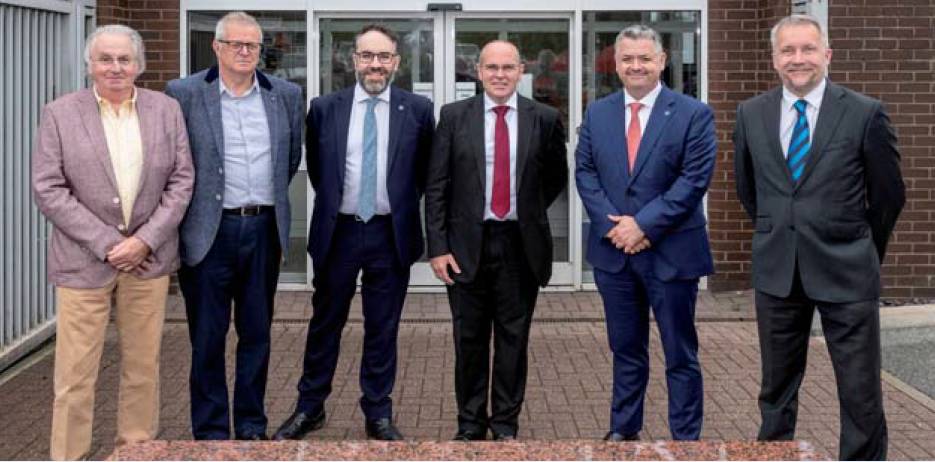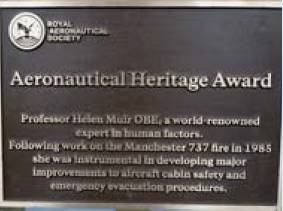Society news
During 2008 the Royal Aeronautical Society (RAeS) introduced an Aeronautical Heritage Award scheme to recognise significant contributions made to ‘the art and science of aeronautics’. The essence of the scheme is to erect plaques to commemorate significant people, places and things. The intention is to celebrate technological or operational achievements that made an original and unique contribution of global significance.
 Guests at the unveiling of the plaque at Warton. From left: Alan Matthews, RAeS Preston Secretary, Martin Rayfield RAeS Preston Treasurer, Mike Elston, Chairman of RAeS Preston Branch, Dave Holmes, BAE Systems Technology and Manufacturing Director, Dave Edwards, RAeS CE and Scott Phillips, RAeS Head of Community Engagement.
Guests at the unveiling of the plaque at Warton. From left: Alan Matthews, RAeS Preston Secretary, Martin Rayfield RAeS Preston Treasurer, Mike Elston, Chairman of RAeS Preston Branch, Dave Holmes, BAE Systems Technology and Manufacturing Director, Dave Edwards, RAeS CE and Scott Phillips, RAeS Head of Community Engagement.
Thursday, 9 June, marked the unveiling of two Aeronautical Heritage plaques recognising the BAE Systems sites at Warton and Samlesbury. Members of the RAeS Preston Branch were joined by the RAeS CE Dave Edwards and RAeS Head of Community Engagement, Scott Phillips.
Of the plaques, Ian Muldowney FRAeS, President of RAeS Preston Branch and BAE Systems Air COO said: “As Chief Operating Officer for BAE Systems Air and an RAeS member myself, I have seen firsthand some of the great, innovative work that our engineers do in the aerospace industry and so being able to commemorate our collective achievements in this way is a really proud moment, not just for those that have come before us, but those that are here today continuing to push forward the BAE Systems innovative legacy.”
Dave Edwards, said; “We’re delighted to be celebrating the role that Samlesbury, Warton and their teams have had on the advancement of aviation and aerospace globally with the unveiling of these plaques. I’m particularly encouraged to see the outreach work being done to get the next generation interested in the amazing opportunities available to everyone in aviation and aerospace.”
An Aeronautical Heritage Award was unveiled at Cranfield University on 20 June, paying tribute to one of the world’s leading experts on air passenger safety. The plaque was given in recognition of Professor Helen Muir’s significant work in developing passenger safety, which influenced the design of today’s aircraft and has resulted in safer air travel.
 The plaque was unveiled by the President of the Royal Aeronautical Society Retd Air Cdre Peter Round with Professor Iain Gray, Director of Aerospace at Cranfield. The event was attended by members of Helen Muir’s family and by Cranfield staff and alumni who had been involved in the evacuation trials.
The plaque was unveiled by the President of the Royal Aeronautical Society Retd Air Cdre Peter Round with Professor Iain Gray, Director of Aerospace at Cranfield. The event was attended by members of Helen Muir’s family and by Cranfield staff and alumni who had been involved in the evacuation trials.
Professor Helen Muir OBE FRAeS was Professor of Aerospace Psychology at Cranfield University, also serving as Dean of Engineering and Pro Vice Chancellor. She was an acknowledged world leader in passenger safety, and an expert in human factors.
After the Manchester air disaster in 1985 when 55 people died in a fire despite the fact that the aircraft was on the runway, it was work led by Helen with her team on cabin evacuation trials which made a major contribution to improve cabin design and cabin crew training in civil aircraft. She developed cabin evacuation test procedures which are mostly still in place today.
Helen was the first chair of the RAeS’ Human Factors group, and was a key player in setting up the Women in Aerospace and Aviation Committee.
In 1999, Professor Muir was awarded the prestigious Whittle Award for her outstanding contribution to airworthiness. In 2004, she received the Sir James Martin Gold Medal from the Guild of Air Pilots and Air Navigators and in 2008 was the first Briton to be given the L Welch Pogue Lifetime Achievement Award for her visionary and pre-eminent leadership in aviation.
Professor Dame Helen Atkinson DBE FREng, Pro-Vice-Chancellor – Aerospace, Transport and Manufacturing at Cranfield University, said: “Many of Professor Muir’s cabin evacuation trials took place at Cranfield and her work here changed aircraft design and made air travel safer. A number of Cranfield staff and students were involved in the evacuation trials in the late 1980s and early 1990s and remember the experience acutely. The influence of her pioneering work still resonates today – and this heritage plaque is a fitting tribute to her ongoing legacy.”
The plaque will be mounted outside Building 83 on Cranfield’s main campus.
Cranfield University is launching a Helen Muir PhD Scholarship fund to commemorate Helen and her work by supporting a PhD student to carry out further work on cabin safety.
 Those present at the unveiling of Professor Muir’s plaque at Cranfield included her husband, Jim Turvey, and stepson, Remy.
Those present at the unveiling of Professor Muir’s plaque at Cranfield included her husband, Jim Turvey, and stepson, Remy.